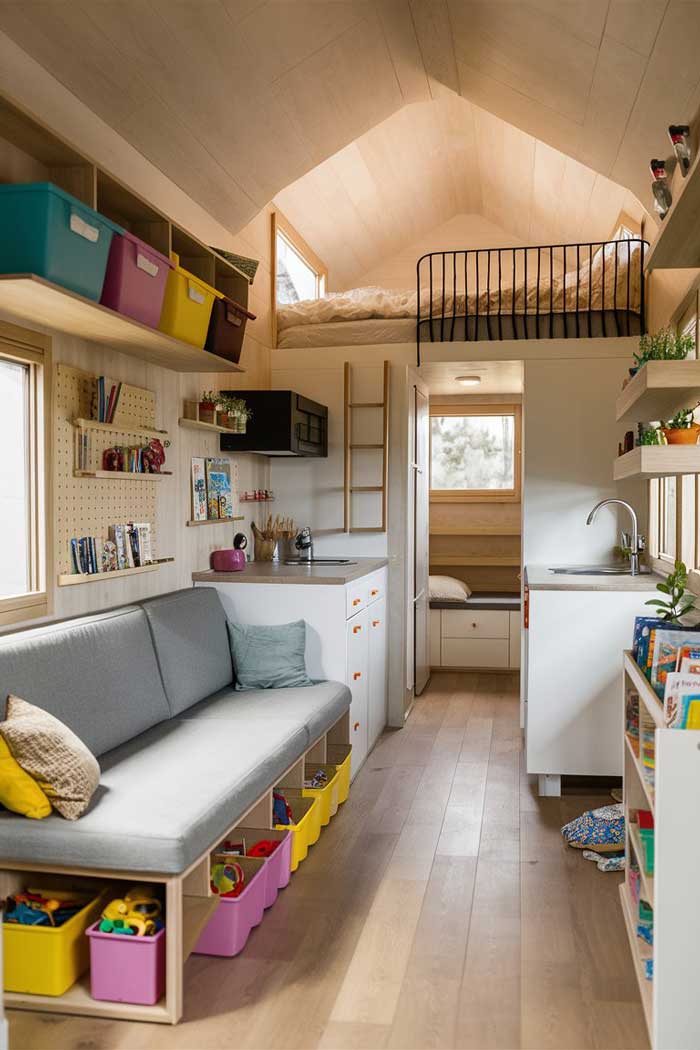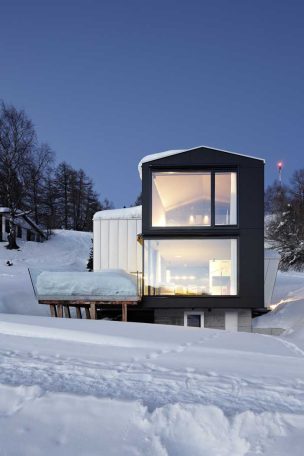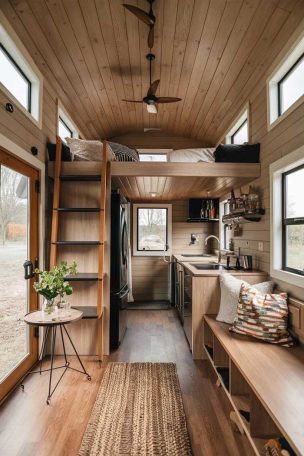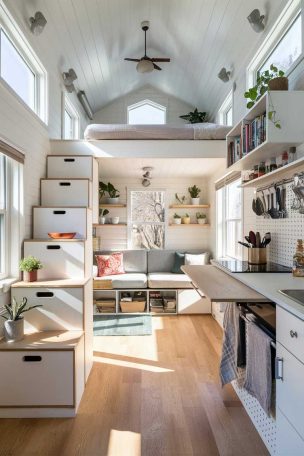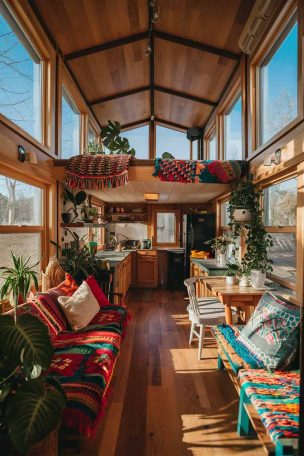The tiny house movement has been gaining momentum for years, with more and more people embracing the simplicity and freedom it offers. But what happens when you throw a toddler into the mix? It’s a question that’s becoming increasingly relevant as young families look to downsize their living spaces and upsize their life experiences.
Living in a tiny house with a toddler is no small feat. It’s a lifestyle that comes with its own unique set of challenges and rewards. From navigating limited space to fostering stronger family bonds, it’s an adventure that requires creativity, patience, and a whole lot of love.
In this article, we’ll dive deep into the world of tiny house living with a toddler. We’ll explore the hurdles you might face, the unexpected joys you’ll discover, and practical tips to make it all work. Whether you’re considering making the leap or just curious about how it all works, buckle up – we’re about to take a journey into the big world of tiny living with little ones.
The Challenges of Tiny House Living with a Toddler
Limited Space
Let’s face it – space is at a premium in any tiny house. With most ranging from a cozy 100 to 400 square feet, you’re looking at an area that’s smaller than many people’s living rooms. Now, add a curious, energetic toddler to that equation, and you’ve got yourself quite the spatial puzzle.
The biggest challenge? Providing enough room for your little one to play, explore, and, well, be a toddler. Toddlers need space to crawl, toddle, and eventually run. They’re natural explorers, constantly on the move, touching everything in sight. In a tiny house, this can feel like a whirlwind of activity in a very small snow globe.
But here’s the thing – it’s not impossible. It just requires some out-of-the-box thinking. Many tiny house parents have found creative ways to maximize every square inch. From convertible furniture to outdoor play areas, there are ways to give your toddler the space they need to grow and develop.
One approach is to think vertically. Wall-mounted toys, hanging baskets for stuffed animals, and high shelves for books can free up valuable floor space. Another strategy is to create multi-functional areas. A living room by day can be transformed into a play area by simply moving a coffee table and rolling out a play mat.
Remember, while the space might be limited, your creativity doesn’t have to be. With some ingenuity, you can turn your tiny house into a toddler-friendly haven that’s both functional and fun.
Privacy Concerns
Privacy – or the lack thereof – is another significant challenge when living in a tiny house with a toddler. In a space where you can practically touch both walls at the same time, finding a moment of solitude can feel like searching for a needle in a haystack.
For parents, this lack of privacy can be particularly taxing. Gone are the days of retreating to another room when you need a breather. In a tiny house, every space is shared space. This can lead to feelings of being overwhelmed, especially during those moments when you just need a few minutes to yourself.
But it’s not just about the parents. Toddlers, too, need their own space sometimes. As they grow and develop, they start to crave independence and may want a little corner to call their own. In a tiny house, providing this can be tricky.
So, how do you create privacy in a space where there are no secrets? It’s all about getting creative with dividers and designated spaces. Some tiny house families use curtains or sliding doors to section off areas of the home. Others create “privacy nooks” – small, cozy spaces where family members can retreat when they need some alone time.
It’s also important to establish clear communication about privacy needs. Maybe you have a system where a closed curtain means “do not disturb,” or perhaps you schedule “quiet time” each day where everyone engages in individual activities.
Remember, while physical space might be limited, respecting each other’s need for mental space is crucial. It’s a balancing act, but with open communication and a bit of creativity, it’s possible to find pockets of privacy even in the tiniest of homes.
Clutter Management
If there’s one thing toddlers excel at, it’s creating clutter. From toys strewn across the floor to books piled high, the mess can accumulate at an alarming rate. Now, imagine all that clutter confined to a tiny house. It’s enough to make even the most organized parent break out in a cold sweat.
In a tiny house, clutter isn’t just unsightly – it can make your living space feel even smaller and more cramped. A few toys on the floor can quickly turn into an obstacle course, and that pile of laundry? It might as well be Mount Everest.
The key to managing clutter in a tiny house with a toddler is twofold: smart storage solutions and a minimalist mindset.
When it comes to storage, think outside the box – or rather, inside every box, nook, and cranny. Under-bed storage can be a lifesaver, providing a home for toys, clothes, or books. Multi-functional furniture, like ottomans with hidden storage or beds with built-in drawers, can help keep clutter at bay.
But storage alone isn’t enough. Living in a tiny house with a toddler often requires a shift towards minimalism. This doesn’t mean getting rid of everything your child loves, but it does mean being intentional about the items you keep. Quality over quantity becomes the mantra.
Many tiny house parents find that rotating toys can be an effective strategy. Keep a selection of toys out, and store the rest away. Every few weeks, swap them out. Not only does this keep the clutter down, but it also makes old toys feel new and exciting again.
Remember, teaching your toddler about tidying up is an important life skill. Make clean-up time a fun daily routine. Use labeled bins or baskets to make it easy for your little one to know where things belong.
Living clutter-free in a tiny house with a toddler is an ongoing process. It requires constant vigilance and a commitment to staying organized. But the payoff – a clean, functional living space – is well worth the effort.
Safety Considerations
Safety is a top priority for any parent, but in a tiny house, it takes on a whole new level of importance. The unique layouts and compact nature of tiny homes can present some unexpected safety challenges when it comes to toddlers.
One of the biggest concerns is the use of lofted spaces. Many tiny houses utilize lofts for sleeping areas to maximize floor space. While these can be cozy and efficient for adults, they can pose a serious fall risk for curious toddlers. If your tiny house includes a loft, it’s crucial to install sturdy railings and consider using safety gates to prevent accidents.
The proximity of different living areas in a tiny house can also be a safety issue. In many designs, the kitchen is just a step away from the living area. This means that hot stoves, sharp utensils, and other kitchen hazards are always within a toddler’s reach. Childproofing becomes not just important but essential.
Here are some specific safety measures to consider:
- Install childproof locks on all cabinets and drawers, especially those containing potentially harmful items.
- Use corner guards on sharp furniture edges to prevent bumps and bruises.
- Secure furniture to walls to prevent tipping, particularly in multi-use pieces that a child might climb.
- Keep electrical outlets covered and cords out of reach.
- If you have a composting toilet, ensure it’s inaccessible to your toddler.
- Consider the placement of your heating source. Wood stoves, for instance, need to be well-protected to prevent burns.
It’s also important to think about emergency situations. In a tiny house, you’re likely to be closer to exits, which can be beneficial. However, make sure you have a clear evacuation plan and that fire extinguishers and smoke detectors are easily accessible.
Remember, safety in a tiny house is an ongoing process. As your toddler grows and becomes more mobile, you’ll need to reassess and adjust your safety measures continually. It might seem like a lot of work, but creating a safe environment will give you peace of mind and allow your little one to explore their tiny home with confidence.
Outdoor Space Limitations
While tiny houses offer cozy interiors, they often come with limited outdoor space. This can be particularly challenging when you have a toddler who needs room to run, play, and burn off energy. The importance of outdoor play for a child’s physical development and overall well-being can’t be overstated, so finding ways to incorporate outdoor time is crucial.
If your tiny house is on a permanent plot, you might have the luxury of a small yard. In this case, make the most of it! Create a designated play area with weather-resistant toys, a sandbox, or even a small climbing structure. If space allows, consider a small garden where your toddler can help plant and tend to vegetables or flowers – a great way to teach about nature and responsibility.
For those with truly limited outdoor space or for tiny houses on wheels, getting creative is key. Here are some ideas:
- Utilize any available outdoor space, no matter how small. Even a small porch or deck can become a play area with the right setup.
- Invest in portable outdoor equipment that can be easily set up and packed away. Things like pop-up tents, inflatable pools, or foldable slides can provide outdoor fun without taking up permanent space.
- Make use of nearby parks and playgrounds. Many tiny house communities are designed with shared outdoor spaces in mind.
- Consider joining local playgroups or classes that meet outdoors. This not only provides play space but also social interaction for both you and your toddler.
- Plan regular outings to nature areas. Hiking trails, beaches, or even urban green spaces can provide the outdoor experience your toddler needs.
Remember, the goal is to ensure your child gets plenty of fresh air and physical activity, even if it’s not right outside your tiny house door. With some planning and creativity, you can overcome the limitations of your immediate outdoor space and provide your toddler with rich, diverse outdoor experiences.
The Rewards of Tiny House Living with a Toddler
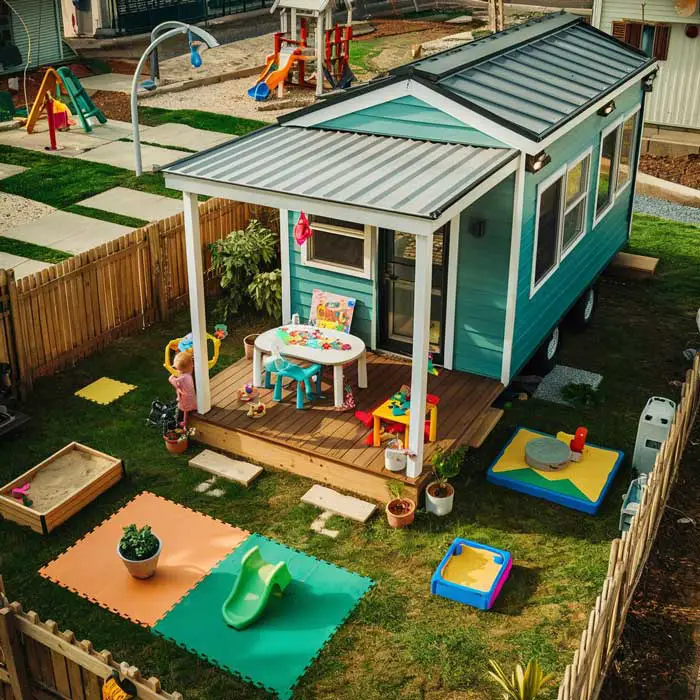
Strengthened Family Bonds
Now, let’s shift gears and talk about one of the most beautiful aspects of tiny house living with a toddler – the incredible bond it can foster within your family. When you’re living in close quarters, interaction isn’t just frequent, it’s constant. And while that might sound overwhelming at first, many families find it leads to a level of closeness they never expected.
In a tiny house, everyday activities become shared experiences. Cooking dinner isn’t just a chore, it’s a family affair. Your toddler might be sitting at the table, “helping” to stir a bowl or playing with measuring cups while you prepare the meal. Bedtime stories aren’t relegated to a quick book in a separate room – they become a cozy family gathering in your multi-functional living space.
This constant togetherness often leads to:
- More meaningful conversations: With fewer distractions and separate spaces, families tend to talk more and engage in deeper discussions.
- Shared experiences: From the mundane to the exciting, you’re experiencing life together in a very immediate way.
- Increased empathy and understanding: Living in close quarters requires a heightened awareness of each other’s needs and moods.
- Collaborative problem-solving: Tiny house challenges often require a team effort, teaching valuable skills to your toddler.
Many tiny house parents report feeling more in tune with their child’s development. You’re there for every new word, every wobbly step, every small discovery. It’s like having front-row seats to your child’s growth.
Of course, it’s not always smooth sailing. Close quarters can also mean more opportunities for conflicts. But even this has a silver lining—it provides ample opportunities to model and teach conflict resolution skills to your toddler.
The memories created in your tiny house are likely to be vivid and lasting. The unique experiences of tiny living – from figuring out creative storage solutions together to snuggling up as a family during a rainstorm – become the stuff of family lore, stories that will be told and retold for years to come.
In essence, tiny house living can create a cocoon of family closeness. It’s an opportunity to strip away the excesses and distractions of modern life and focus on what truly matters – the relationships within your family unit.
Embracing Simplicity and Minimalism
One of the most profound rewards of tiny house living with a toddler is the opportunity to embrace simplicity and minimalism. In a world that often equates success with accumulation, choosing to live with less can be a powerful lesson for your growing child.
Living in a tiny house naturally limits the amount of stuff you can own. This isn’t just about physical space – it’s about shifting your mindset from quantity to quality. For toddlers, who are just beginning to form their understanding of the world, this can shape their values in meaningful ways.
Here’s how embracing simplicity and minimalism can benefit your family:
- Focus on experiences over things: With limited space for toys and gadgets, the emphasis naturally shifts to shared experiences and quality time. A nature walk becomes more exciting than a new plastic toy.
- Appreciation for what you have: When you have fewer possessions, each item tends to be more valued. Your toddler may develop a deeper appreciation for their favorite toys or books.
- Environmental consciousness: Living with less often translates to a smaller environmental footprint. This early exposure can foster a lifelong commitment to sustainability in your child.
- Creativity and imagination: With fewer ready-made entertainment options, children often become more creative in their play. A cardboard box might become a spaceship one day and a castle the next.
- Financial literacy: Tiny house living often comes with financial benefits. This can be an opportunity to start teaching your toddler about money, saving, and making mindful choices about purchases.
Many parents find that this simplified lifestyle leads to less stress and more contentment. Without the pressure to constantly acquire new things, you’re free to focus on what truly brings joy to your family.
It’s important to note that embracing minimalism with a toddler doesn’t mean depriving them of toys or experiences. Rather, it’s about being intentional with your choices. Maybe instead of a room full of toys, your child has a carefully curated collection of open-ended playthings that spark imagination and can grow with them.
This mindset can extend beyond material possessions. Many tiny house families find they simplify their schedules, too, focusing on quality family time rather than endless activities and commitments.
Remember, toddlers learn by example. By choosing to live simply and mindfully in your tiny house, you’re setting a powerful precedent for your child’s future relationship with material goods and what truly constitutes a rich, fulfilling life.
Financial Freedom
One of the most tangible benefits of tiny house living, especially for young families, is the potential for greater financial freedom. The reduced costs associated with living in a smaller space can have a profound impact on your family’s financial health and, by extension, your overall quality of life.
Let’s break down how tiny house living can lead to financial benefits:
- Lower housing costs: Whether you’re buying or building, a tiny house typically costs significantly less than a traditional home. This means lower mortgage payments or, in some cases, the ability to own your home outright.
- Reduced utility bills: With less space to heat, cool, and light, your monthly utility costs can plummet. Many tiny houses are also designed with energy efficiency in mind, further reducing these expenses.
- Less space for unnecessary purchases: When every square inch counts, you’re less likely to buy things you don’t need. This natural curb on spending can lead to significant savings over time.
- Lower property taxes: If your tiny house is on a permanent foundation, you’ll likely pay much less in property taxes compared to a traditional home.
- Decreased maintenance costs: With less space and fewer possessions, there’s simply less to maintain and repair.
But what does this financial freedom mean for your family, particularly for raising a toddler? Here are some potential benefits:
- More quality time: If you’re spending less on housing and associated costs, you might be able to work fewer hours or have more flexibility in your work arrangements. This can translate to more time spent with your little one during these crucial early years.
- Investment in experiences: With more disposable income, you might be able to invest in enriching experiences for your family. This could mean travel, educational opportunities, or simply the ability to say “yes” more often to activities that foster your toddler’s growth and development.
- Reduced stress: Financial strain is a significant source of stress for many families. By reducing your living expenses, you may find that you’re able to breathe easier and enjoy your time with your toddler more fully.
- Future planning: The money saved through tiny house living could be redirected towards your child’s future – perhaps a college fund or savings for future opportunities.
- Modeling financial responsibility: Living within (or below) your means sets a powerful example for your child about financial management and the value of experiences over material possessions.
It’s important to note that tiny house living isn’t a financial panacea. There are costs associated with this lifestyle, and the savings can vary depending on your specific situation. However, for many families, the financial benefits of downsizing to a tiny house can be substantial.
By choosing to live in a tiny house with your toddler, you’re not just making a housing decision – you’re potentially reshaping your family’s financial future. The freedom that comes with reduced financial burden can open up a world of possibilities for you and your little one.
Practical Tips for Success
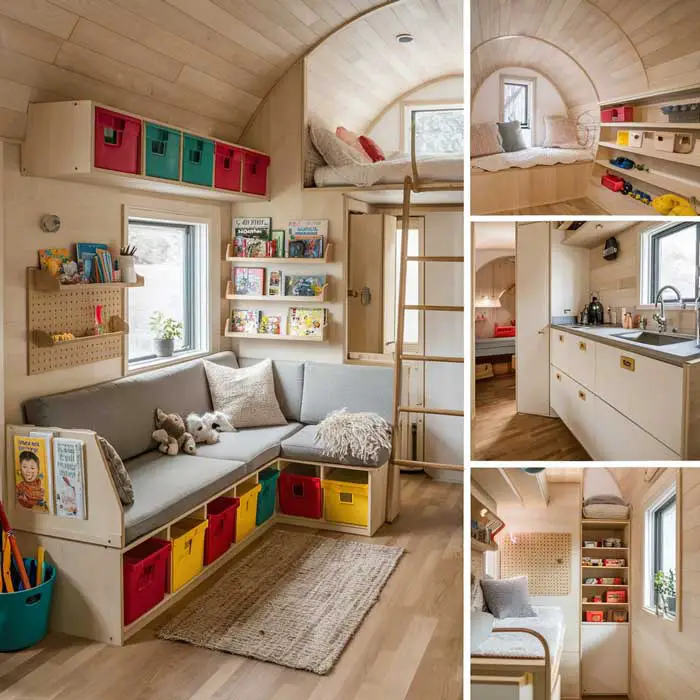
Optimizing Layout and Design
When it comes to tiny house living with a toddler, the layout and design of your space can make all the difference between feeling cramped and chaotic or cozy and content. Thoughtful planning and clever design solutions can help you create a home that works for everyone, no matter how small.
Here are some key considerations for optimizing your tiny house layout:
Certainly! Let’s continue with the practical tips for optimizing layout and design in a tiny house with a toddler.
Optimizing Layout and Design (continued)
- Multi-functional spaces: In a tiny house, every area needs to pull double (or even triple) duty. Your living room might also be your child’s play area and your home office. Consider furniture that can be easily moved or transformed. For example, a coffee table that converts to a toddler-height activity table, or a sofa that turns into a guest bed.
- Vertical thinking: When floor space is limited, look up! Utilize wall space for storage, play areas, and even sleeping lofts. Just remember to prioritize safety with sturdy railings and secure attachments.
- Built-in storage: Work with your builder or designer to incorporate storage into every possible nook and cranny. Under-stair storage, built-in cabinets, and hidden compartments can help keep clutter at bay.
- Open floor plans: An open concept can make your tiny house feel more spacious. However, consider using room dividers or curtains to create separate “zones” when needed.
- Child-friendly features: Incorporate elements specifically designed for your toddler. This might include a low shelf for books, a built-in art station, or a cozy reading nook.
- Safety first: Ensure that your layout prioritizes safety. This might mean rounding corners, securing furniture to walls, and creating clear pathways for your toddler to move around safely.
- Future-proofing: While designing for your toddler’s current needs, also consider how the space can adapt as they grow. Convertible furniture and flexible spaces can help your tiny house evolve with your family.
- Outdoor connection: If possible, design your tiny house to connect seamlessly with outdoor spaces. Large windows, a small deck, or even just a strategically placed door can help extend your living area and provide crucial play space for your toddler.
Remember, the key to successful tiny house living with a toddler is flexibility. Your needs will change as your child grows, so aim for a design that can adapt and evolve over time. Don’t be afraid to experiment and make changes as you discover what works best for your family.
Creative Storage Solutions
In a tiny house with a toddler, smart storage isn’t just helpful – it’s essential. Here are some innovative storage ideas to keep your small space organized and clutter-free:
- Under-bed storage: Invest in beds with built-in drawers or use low-profile storage containers that can slide underneath. This space is perfect for storing out-of-season clothes, extra bedding, or less frequently used toys.
- Wall-mounted shelves and baskets: Utilize vertical space by installing shelves at various heights. Lower shelves can hold toys and books within your toddler’s reach, while higher ones can store items that need to be kept out of little hands.
- Over-door organizers: These hanging solutions can turn the back of any door into valuable storage space. Use them for shoes, accessories, or even art supplies.
- Magnetic strips: Install magnetic strips on walls or the sides of cabinets to hold small metal toys and art supplies or even to create a vertical play space for magnetic toys.
- Rotating toy system: Keep a limited selection of toys out at any given time, storing the rest away in labeled bins. Rotate the toys every few weeks to keep things fresh and exciting for your toddler while maintaining a clutter-free space.
- Multi-functional furniture: Opt for pieces that offer hidden storage, like ottomans with removable tops, coffee tables with drawers, or dining benches with storage underneath.
- Pegboards: These versatile boards can be used to hang toys, art supplies, or even clothing items, keeping them off the floor and easily visible.
- Corner shelves: Make use of often-overlooked corner spaces with triangular shelving units.
- Hanging organizers: Use fabric pockets that hang from the ceiling or walls to store stuffed animals, books, or other lightweight items.
- Vacuum storage bags: These can compress bulky items like winter coats or extra blankets, making them much easier to store in small spaces.
Remember, the key to effective storage in a tiny house is to make everything accessible and easy to clean up. Label bins and baskets so your toddler can help with tidying, and try to keep a place for everything and everything in its place. With these creative solutions, you can maintain an organized and functional tiny home, even with a toddler in tow.
Designing for Play and Learning
Creating an environment that fosters play and learning is crucial in any home, but it requires extra creativity in a tiny house. Here’s how you can design a space that nurtures your toddler’s development:
- Create a dedicated play area: Even if it’s just a corner of your main living space, having a designated area for play can help contain the mess and give your toddler a sense of ownership. Use a colorful rug to define the space and add low shelves or bins for easy toy access.
- Incorporate learning into everyday spaces: Use chalkboard paint on a cabinet door to create a drawing surface, or add alphabet magnets to the refrigerator. These small additions can turn any area into a learning opportunity.
- Utilize vertical space for activities: Install a pegboard or magnetic wall where your toddler can engage in vertical play. This can be great for fine motor skills and saves floor space.
- Make use of transformable spaces: A dining table can become an art station with the addition of a washable tablecloth and some art supplies. A loft bed area might double as a cozy reading nook during the day.
- Outdoor learning: If possible, create an outdoor space for nature exploration and messy play. A small garden patch or even potted plants can teach your toddler about growth and responsibility.
- Incorporate sensory elements: Add different textures to your tiny house with soft pillows, rough baskets, or smooth wooden toys. These varied sensory experiences are crucial for toddler development.
- Create a cozy reading nook: Carve out a small, comfortable space for reading. This could be a window seat, a small tent, or even just a designated corner with cushions and a book basket.
- Use walls for interactive play: Consider installing a small rock climbing wall, a felt board for storytelling, or a height chart that doubles as a growth-tracking activity.
- Invest in open-ended toys: Choose toys that can be used in multiple ways, like blocks, playdough, or dress-up clothes. These encourage creativity and take up less space than large, single-purpose toys.
- Make storage part of play: Use clear, stackable containers for toy storage. This not only keeps things organized but also allows your toddler to see what’s inside, encouraging independent play choices.
Remember, in a tiny house, flexibility is key. Your play and learning spaces may need to be set up and packed away as part of your daily routine. Embrace this as an opportunity to teach your toddler about organization and respect for shared spaces.
By thoughtfully designing your tiny house with your toddler’s developmental needs in mind, you can create a rich, stimulating environment that supports their growth and learning, regardless of your home’s size.
Maintaining Organization
Keeping a tiny house organized with a toddler around can feel like a Herculean task, but with the right strategies, it’s entirely possible. Here are some tips to help you maintain order in your small space:
- Implement a “one in, one out” rule: For every new item that comes into your home, an old one should go out. This helps prevent accumulation and keeps your belongings manageable.
- Establish daily tidy-up routines: Make cleaning up a regular part of your day. Have a quick tidy-up session before nap time and another before bed. Involve your toddler in these routines to teach them about responsibility and organization.
- Use clear, labeled containers: Clear bins allow you to see what’s inside at a glance, while labels (picture labels work great for toddlers) make it easy for everyone to know where things belong.
- Create a place for everything: In a tiny house, every item needs a designated spot. This makes it easier to put things away and helps prevent clutter from accumulating.
- Regularly declutter: Set aside time each month to go through your belongings and decide what you truly need. Be ruthless – in a tiny house, every item should earn its keep.
- Use vertical storage: Maximize your wall space with shelves, hooks, and hanging organizers. This keeps floor space clear and makes items easily accessible.
- Embrace multi-functional items: Choose furniture and accessories that serve multiple purposes. A storage ottoman, for example, can be seating, storage, and a play surface all in one.
- Digitize where possible: Scan important documents and store them digitally to reduce paper clutter. The same goes for books – consider e-books for your own reading to save space.
- Rotate toys and books: Keep only a selection of toys and books out at a time, storing the rest away. Rotate them regularly to keep things fresh and exciting for your toddler without overwhelming your space.
- Teach your toddler about organization: Make tidying up a game. Use songs, timers, or other fun techniques to encourage your little one to participate in keeping your home organized.
- Do a nightly reset: Before bed each night, spend 10-15 minutes resetting your space. Put away toys and clear surfaces, and prepare for the next day. Waking up to a tidy space can set a positive tone for the whole day.
- Use door and wall space: Over-the-door organizers, wall-mounted baskets, and magnetic strips can all provide extra storage without taking up precious floor space.
Remember, maintaining organization in a tiny house with a toddler is an ongoing process. It requires consistency and patience. Some days will be messier than others, and that’s okay. The goal is to create systems that work for your family and make tidying up a natural part of your daily routine.
By keeping your tiny house organized, you’re not just creating a more pleasant living environment – you’re also teaching your toddler valuable life skills about responsibility, respect for shared spaces, and the benefits of living with less.
Overcoming Social Challenges
Living in a tiny house with a toddler can present unique social challenges. From maintaining connections with friends and family to ensuring your child has ample opportunities for socialization, it’s important to be proactive in addressing these aspects of tiny house life.
Building Community Connections
One of the biggest concerns for tiny house families is the potential for social isolation. Here’s how you can build and maintain strong community connections:
- Seek out tiny house communities: Many areas now have dedicated tiny house communities or neighborhoods. Living in such a community can provide built-in social connections with like-minded families.
- Attend local events: Make an effort to participate in community events, farmers markets, or local festivals. These can be great opportunities for both you and your toddler to meet people and feel connected to your wider community.
- Join parent groups: Look for local parenting groups or playgroups. These can be invaluable for both socializing your toddler and providing you with a support network of other parents.
- Utilize public spaces: Parks, libraries, and community centers can become extensions of your living space. Regular visits to these places can help your toddler form friendships and give you a chance to connect with other parents.
- Host gatherings creatively: While your tiny house might not accommodate large dinner parties, you can still host gatherings. Consider picnics in the park, potlucks where everyone brings a dish, or even progressive dinners with other tiny house families.
- Embrace online communities: Join online forums or social media groups for tiny house dwellers or local parents. These can be great resources for advice, support, and even organizing meet-ups.
- Volunteer: Engaging in volunteer work as a family can help you feel more connected to your community and teach your toddler valuable lessons about giving back.
Remember, building community takes time and effort. Don’t be discouraged if it doesn’t happen overnight. Keep putting yourself out there, and you’ll likely find that many people are curious about and interested in your tiny house lifestyle.
Adapting Social Activities
Living in a tiny house doesn’t mean you have to give up on social activities. It just means you might need to approach them a bit differently. Here are some ideas:
- Outdoor entertaining: Make the most of any outdoor space you have, whether it’s a small patio, a shared community area, or a nearby park. Invest in some portable outdoor furniture and embrace picnic-style gatherings.
- Activity-based socializing: Instead of hosting at home, meet friends for activities. Playdates at the park, visits to the zoo, or trips to child-friendly museums can be great ways to socialize.
- Rotate hosting duties: If you have friends with larger homes, don’t be afraid to accept their invitations to host. You can contribute in other ways, like bringing food or helping with cleanup.
- Embrace minimalist parties: When you do host at home, keep it simple. A movie night with a few close friends, a craft afternoon for your toddler and a couple of their friends, or a potluck brunch can all work well in a small space.
- Virtual connections: While not a replacement for in-person interaction, video calls can be a great way to stay connected with far-flung family and friends. Set up regular virtual playdates for your toddler with cousins or friends who live far away.
- Community spaces: Look into renting community spaces for larger gatherings. Many libraries, community centers, or even restaurants have rooms you can reserve for special occasions.
- Be open about your space: Let friends and family know about your living situation. Most people will be understanding and happy to adapt plans to accommodate your lifestyle.
Living in a tiny house with a toddler doesn’t mean sacrificing your social life. It just requires a bit of creativity and flexibility. By thinking outside the box and being open to new ways of connecting, you can ensure that both you and your toddler maintain rich, fulfilling social lives.
Planning for the Future
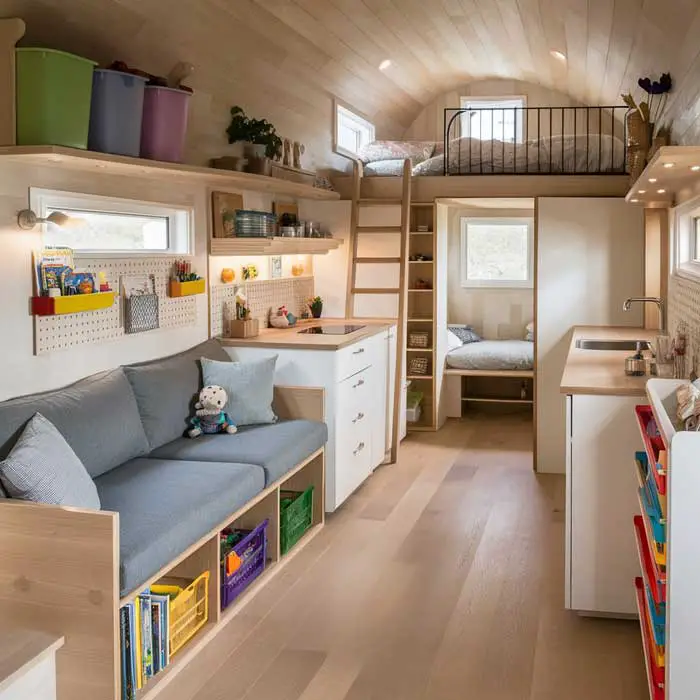
As your toddler grows, your needs as a family will evolve. It’s important to think ahead and consider how your tiny house lifestyle can adapt to these changes.
Adaptable Design Considerations
- Flexible spaces: Design areas that can serve multiple purposes and change as your child grows. For example, a play area could later become a study nook.
- Modular furniture: Invest in pieces that can be reconfigured or expanded as needed. This might include stackable beds or extendable tables.
- Expandable options: If possible, design your tiny house with the potential for future expansion. This could mean adding a small addition or having a plan to combine two tiny houses as your family grows.
- Storage solutions that grow: Choose storage systems that can adapt to changing needs. Adjustable shelving or modular closet systems can be reconfigured as your child’s storage needs change.
- Tech-ready spaces: As your toddler grows, they may need space for computers or other technology for schoolwork. Plan for where these items could be accommodated in the future.
Educational Aspects
- Homeschooling considerations: Many tiny house families opt for homeschooling or alternative education models. If this is a possibility for you, think about how you could create a learning space within your tiny house.
- Outdoor learning: Maximize your outdoor space (if you have it) for learning opportunities. A small garden can teach biology, while a simple weather station can introduce meteorology concepts.
- Community resources: Research local libraries, museums, and other educational resources. These can supplement your home learning environment and provide valuable experiences for your growing child.
- Travel opportunities: One of the benefits of tiny house living can be increased financial flexibility. Consider how you might use this to provide enriching travel experiences for your child as they grow.
Remember, the key to successfully raising a child in a tiny house is flexibility and adaptability. Your space and your lifestyle will need to evolve as your child grows. By planning ahead and remaining open to change, you can create a nurturing environment that supports your child’s development at every stage.
Conclusion
Living in a tiny house with a toddler is undoubtedly a unique experience. It comes with its fair share of challenges, from managing limited space to ensuring adequate socialization opportunities. However, it also offers remarkable rewards, including stronger family bonds, financial freedom, and the opportunity to teach valuable life lessons about simplicity and mindful living.
The key to success in this lifestyle lies in creative problem-solving, adaptability, and a willingness to think outside the box. By optimizing your space, implementing smart storage solutions, and focusing on experiences rather than possessions, you can create a rich, nurturing environment for your toddler to thrive.
Remember, there’s no one-size-fits-all approach to tiny house living with a toddler. What works for one family may not work for another. Be patient with yourself as you figure out what works best for your unique situation. Don’t be afraid to make changes and adjust your approach as your child grows and your family’s needs evolve.
Ultimately, the decision to raise a toddler in a tiny house is about more than just living in a small space. It’s about choosing a lifestyle that aligns with your values, prioritizes family connections, and focuses on what truly matters. With thoughtful planning, creativity, and a positive attitude, tiny house living with a toddler can be an incredibly rewarding experience that sets the foundation for a lifetime of close family bonds and mindful living.

